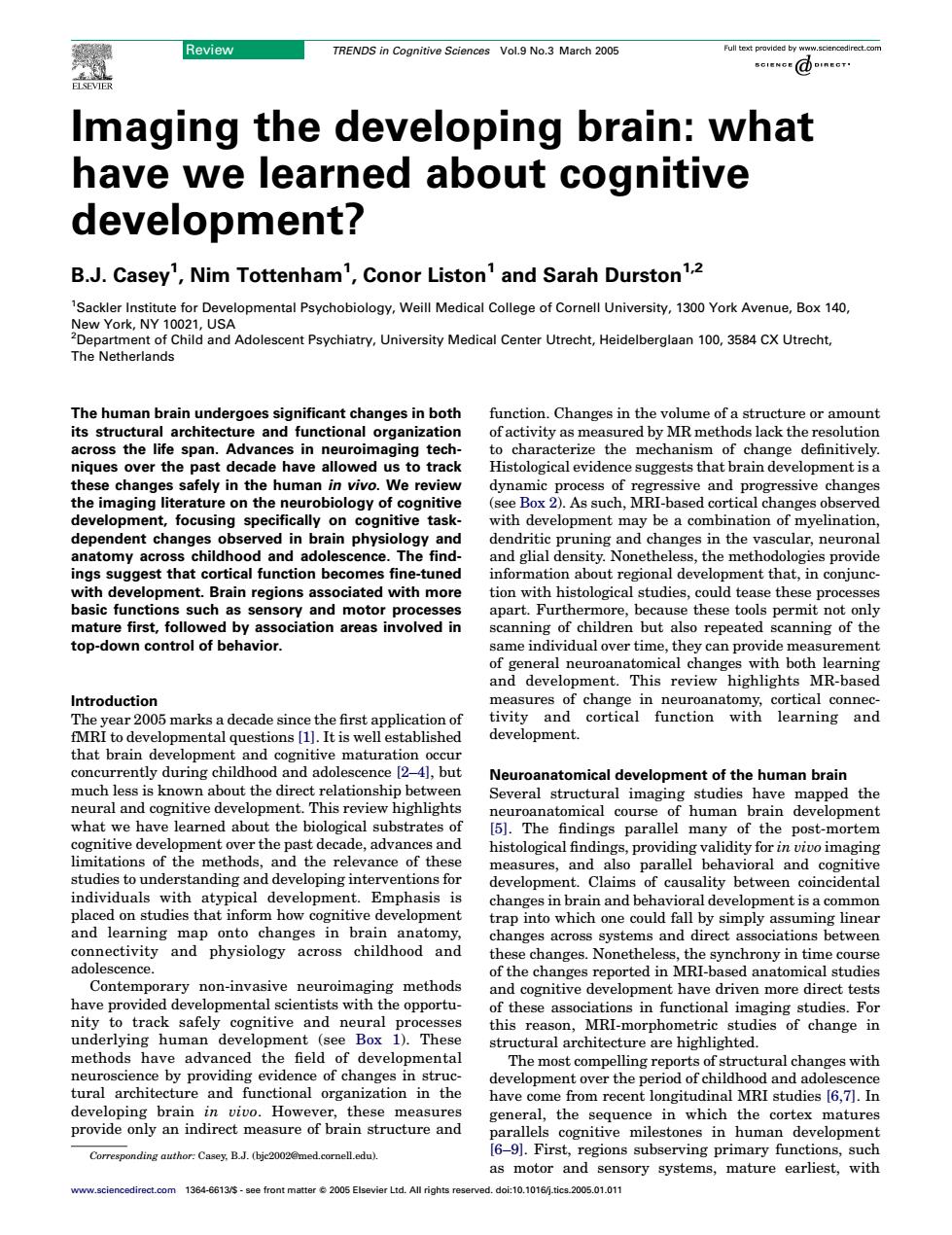正在加载图片...

Review setstdntr Imaging the developing brain:what have we learned about cognitive development? B.J.Casey',Nim Tottenham1,Conor Liston'and Sarah Durston1.2 Sackler nstitute for Developmental Psychobiology Weill Medical orell University,3 York Avenue,Box 140. dolescn Pychatry University Medical Crect,Hidr 100.xech The Netherlands function.changes in the yolume of a structure or of activity s measured by MR methods lack the resolution ross the Iite spa ro tech characterize the mechanism of change definitive these change s safely in the human in vivo.We review dynamic essive change the imaging lite ve e Box ed nendent cha nd and change in the atomy across childhood the methodolog gies provide ngs s ggest th nne-tune d in conjun basic functic Follation areas mo ce mature fi onteoiofbehx s but also repeatec canning of th of g eral neuroanatomical changes with both learning and evelophishtMR-bas development. he neural and cognitive development.This review what we have learned about the bi limitations of the methods,and the relevance of these ngs,providing ing and ons fo development.Claims of causalitybetween coincidenta hes gin g methods de with the opportu underlying human development see Box D).These methods hay e advanced the field developmental of changes with tural architecture and functional the of childh general,the sequence in which the cortex matures escognitive milestones in human Casey BJ.(bie200 and con .dot10.101 6Ltica.200s.01.01 Imaging the developing brain: what have we learned about cognitive development? B.J. Casey1 , Nim Tottenham1 , Conor Liston1 and Sarah Durston1,2 1 Sackler Institute for Developmental Psychobiology, Weill Medical College of Cornell University, 1300 York Avenue, Box 140, New York, NY 10021, USA 2 Department of Child and Adolescent Psychiatry, University Medical Center Utrecht, Heidelberglaan 100, 3584 CX Utrecht, The Netherlands The human brain undergoes significant changes in both its structural architecture and functional organization across the life span. Advances in neuroimaging techniques over the past decade have allowed us to track these changes safely in the human in vivo. We review the imaging literature on the neurobiology of cognitive development, focusing specifically on cognitive taskdependent changes observed in brain physiology and anatomy across childhood and adolescence. The findings suggest that cortical function becomes fine-tuned with development. Brain regions associated with more basic functions such as sensory and motor processes mature first, followed by association areas involved in top-down control of behavior. Introduction The year 2005 marks a decade since the first application of fMRI to developmental questions [1]. It is well established that brain development and cognitive maturation occur concurrently during childhood and adolescence [2–4], but much less is known about the direct relationship between neural and cognitive development. This review highlights what we have learned about the biological substrates of cognitive development over the past decade, advances and limitations of the methods, and the relevance of these studies to understanding and developing interventions for individuals with atypical development. Emphasis is placed on studies that inform how cognitive development and learning map onto changes in brain anatomy, connectivity and physiology across childhood and adolescence. Contemporary non-invasive neuroimaging methods have provided developmental scientists with the opportunity to track safely cognitive and neural processes underlying human development (see Box 1). These methods have advanced the field of developmental neuroscience by providing evidence of changes in structural architecture and functional organization in the developing brain in vivo. However, these measures provide only an indirect measure of brain structure and function. Changes in the volume of a structure or amount of activity as measured by MR methods lack the resolution to characterize the mechanism of change definitively. Histological evidence suggests that brain development is a dynamic process of regressive and progressive changes (see Box 2). As such, MRI-based cortical changes observed with development may be a combination of myelination, dendritic pruning and changes in the vascular, neuronal and glial density. Nonetheless, the methodologies provide information about regional development that, in conjunction with histological studies, could tease these processes apart. Furthermore, because these tools permit not only scanning of children but also repeated scanning of the same individual over time, they can provide measurement of general neuroanatomical changes with both learning and development. This review highlights MR-based measures of change in neuroanatomy, cortical connectivity and cortical function with learning and development. Neuroanatomical development of the human brain Several structural imaging studies have mapped the neuroanatomical course of human brain development [5]. The findings parallel many of the post-mortem histological findings, providing validity for in vivo imaging measures, and also parallel behavioral and cognitive development. Claims of causality between coincidental changes in brain and behavioral development is a common trap into which one could fall by simply assuming linear changes across systems and direct associations between these changes. Nonetheless, the synchrony in time course of the changes reported in MRI-based anatomical studies and cognitive development have driven more direct tests of these associations in functional imaging studies. For this reason, MRI-morphometric studies of change in structural architecture are highlighted. The most compelling reports of structural changes with development over the period of childhood and adolescence have come from recent longitudinal MRI studies [6,7]. In general, the sequence in which the cortex matures parallels cognitive milestones in human development [6–9]. First, regions subserving primary functions, such as motor and sensory systems, mature earliest, with Corresponding author: Casey, B.J. (bjc2002@med.cornell.edu). Review TRENDS in Cognitive Sciences Vol.9 No.3 March 2005 www.sciencedirect.com 1364-6613/$ - see front matter Q 2005 Elsevier Ltd. All rights reserved. doi:10.1016/j.tics.2005.01.011